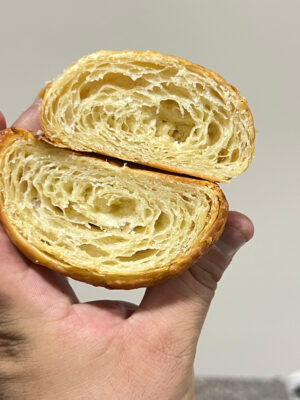Scoolinary › Forums › Ask a question › Croissant layers
-
Croissant layers
Escrito por ramihajj607 on abril 12, 2025 en 09:53Sussan Estela Olaya respondió hace 5 días, 19 horas 4 Miembros · 4 Respuestas -
4 Respuestas
-
Level:
Scoolinary Team
Hi Rami.
Welcome to the Scoolinary community!
Looking at the image, your croissant has a generally good structure, but the layers in the center are not well defined , it looks a bit dense, as if the layers have merged or didn’t expand properly.
Here are some possible causes and tips to help improve it:
Common reasons for poorly defined layers:
1. Over or under proofing during the final fermentation:
If you overproof, the butter may melt too early and mix into the dough.
If you underproof, the croissant doesn’t build enough strength to allow the layers to expand properly during baking.
Tip: A good sign of proper final proofing is when the croissant has doubled in size and jiggles slightly like gelatin when gently moved. It should also offer little resistance to the touch, without collapsing.
2. Lamination issues (folding and rolling):
If you press too hard while rolling, the layers may stick together.
If the temperature is too warm during lamination, the butter softens too much and blends into the dough.
Tip: Work in an environment between 16–18°C (60–65°F) and use high-quality butter.
3. Oven temperature too low or not enough bottom heat:
If your oven lacks a strong initial heat, the layers won’t rise properly and the croissant will spread outward instead of upward.
Tip: Preheat the oven for 20 to 25 minutes before baking (ideally to 170°C / 340°F). That initial heat boost is key.
4. Incorrect shaping:
If the croissant isn’t rolled tightly from the base, the center can become compressed.
Tip: Make sure to apply tension while rolling, and tuck the tip of the triangle underneath to prevent it from unrolling.
Extra tips:
Use flour with good strength (12–13% protein, with a P/L ratio between 0.4 and 0.7) so the dough can handle the lamination without tearing.
Make sure the butter has a similar plasticity to the dough before incorporating it — not too cold, not too soft.
Hope this helps! If you have any other questions, I’m here and happy to help.
Best regards.
-
Level:
Scoolinary Team
Good luck with your next attempt, Rami! We hope Sussan’s advice was helpful. We’ll be right here, cheering you on and excited to see what you create next! 💪✨
-
I have had this happen when I have done too many folds. 🙄🤣
On the rare occasion that it has happened, it’s because I forgot how many I had done.
I know right? How could I forget where I am after the second fold. LOL. 🤣
Too many folds causes the layers to be compressed together.
With the correct amount of folds but rolling your dough too thin can cause this as well.
Looking at your picture, it seems to have more of a bread like internal structure.
What recipe did you use?
-
Level:
Scoolinary Team
Hi Cary, what you mentioned about sometimes losing track while laminating the dough is a great point , it really helps explain why it can end up looking more like a “brioche” than a croissant.
It totally makes sense; the more layers or extra laminating, the more definition gets lost.
Thanks for sharing that insight , it’s really helpful for the community! ☺️
-
Log in to reply.


